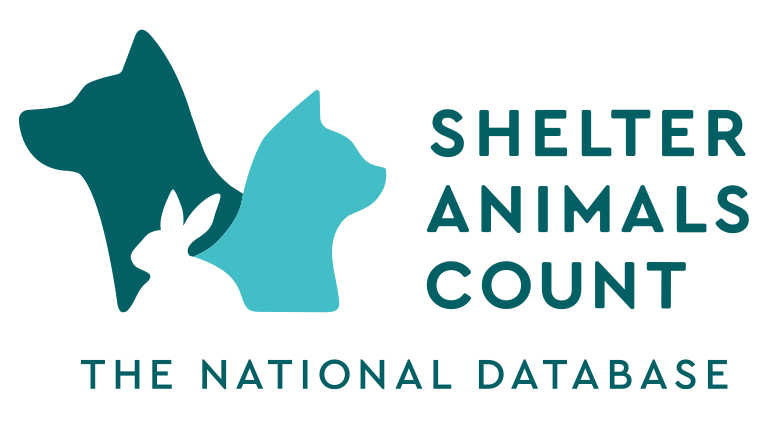From Data to Action: Navigating Kitten Season 2025 - Shelter Animals Count
- Home
- From Data to Action: Navigating Kitten Season 2025
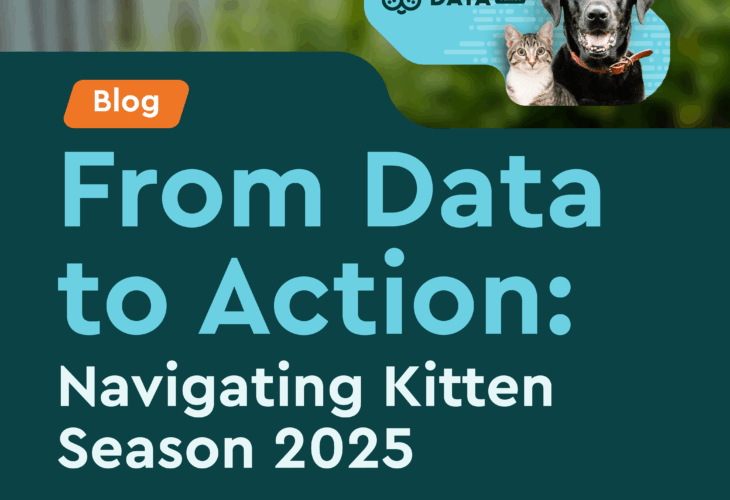
20May’25
From Data to Action: Navigating Kitten Season 2025
Every year, shelters and rescues brace themselves for an influx of kittens as the weather warms. Thanks to our exclusive Animal Level Data at Shelter Animals Count, we can analyze trends and provide insights that help organizations prepare for the seasonal shifts in intake. Our 2024 data sheds light on community intake patterns by age group, the ages of kittens entering shelters, regional analysis, and the non-live outcomes affecting kittens the most. With these insights, we can better prepare for what the rest of 2025 will look like for kittens entering shelters and rescues.
This blog is part of our Unlocking Animal Data series, powered by Hill’s Pet Nutrition.
Seasonal Trends in Cat Intakes
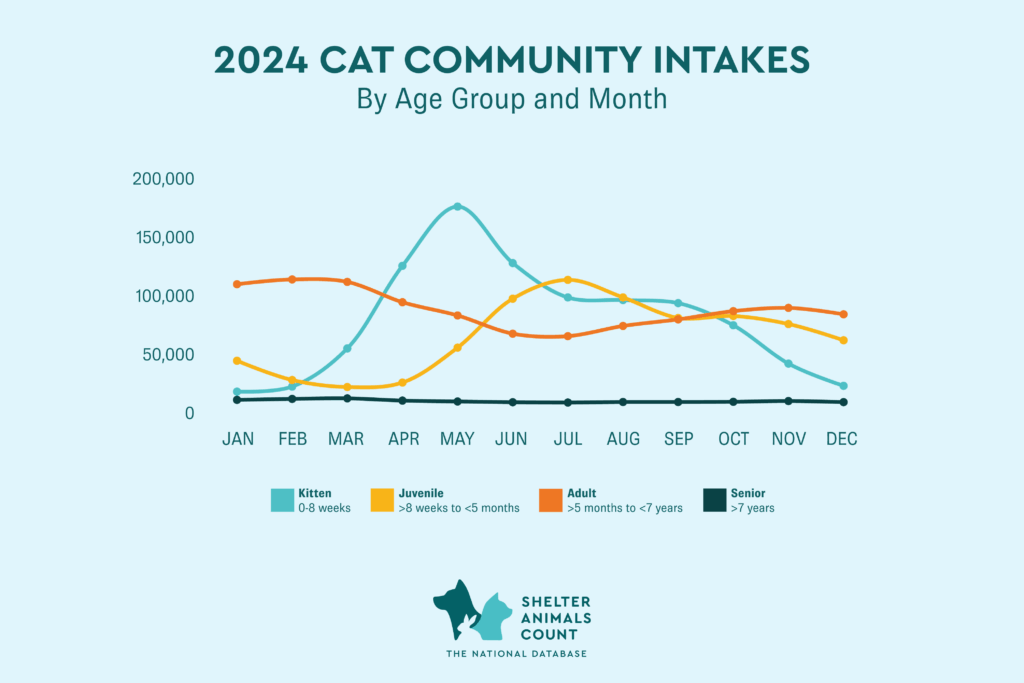
Community intake data (intakes not including transfers) for 2024 highlights clear seasonal patterns in cat admissions. Adult cats (5 months to 7 years old) make up the majority of intakes until April, when kittens (0-8 weeks old) begin to dominate. The percentage of kitten intakes continues to rise, peaking in May and remaining the highest through June. By July, juvenile cats (8 weeks to under 5 months) become the predominant age group entering shelters. By Q4, adult cats once again take the lead in intakes, signaling a return to pre-kitten season intake levels.
Differences by Age Group
- + Kittens (0-8 weeks): Their intake starts increasing in February and March, with the highest surge occurring in May.
- + Juveniles (>8 weeks to <5 months): This group peaks in July, as many young kittens grow older and continue to enter shelters.
- + Adults (>5 months to <7 years): Adults remain the most common intake group from January to March and regain dominance in Q4.
- + Seniors (>7 years): Senior cat intake remains relatively steady throughout the year, making up a small but consistent percentage of community intakes.
Regional Insights of Kitten Intakes

A notable exception to the nationwide trends is New England. Unlike other regions, New England does not see the same dramatic increases in kitten intake from February through May. This deviation may be due to a combination of factors, including lower outdoor cat populations, higher rates of spay/neuter programs, and different climate-related breeding cycles.
Additionally, when we look at the percentage of total intakes by region and compare kittens to juveniles, we see a clear shift. These two charts depict regional trends in the percentage of total feline intakes that are either kittens under 8 weeks old or juveniles (8 weeks to 5 months old) throughout the calendar year. The data offers a clear seasonal picture of when organizations across the U.S. experience an influx of very young cats — a critical insight for operational planning, resource allocation, and lifesaving interventions. For a map of the US regions analyzed by Shelter Animals Count, visit this page.


- + Seasonal Spike: Across all regions, kitten intakes peak dramatically between April and June, with the highest percentage occurring in May. In many regions, over 50% of total feline intakes during this time are kittens under 8 weeks old.
- + Off-Season Dip: From November through February, kitten intake percentages are at their lowest across all regions, often comprising less than 10% of total cat intakes.
Juvenile Intakes (8 Weeks to 5 Months Old)
- + Lagging Increase: Juvenile intakes show a corresponding rise beginning in May and June, following the kitten intake spike. This reflects the natural aging of kittens brought in during the spring.
- + Sustained Volume: While not peaking as sharply as kittens, juvenile intakes remain elevated through the summer and early fall, with a noticeable taper starting in September.
- + Regional Consistency: Most regions follow the same general curve, with the Middle Atlantic region reporting notably lower percentages of juveniles throughout the year, especially from June through October.
- + End-of-Year Rise: Nationally and in several regions (e.g., National, West North Central), there’s a slight uptick in juvenile intakes in November and December, likely due to the delayed intake or identification of late-season litters.
Non-Live Outcomes for Kittens
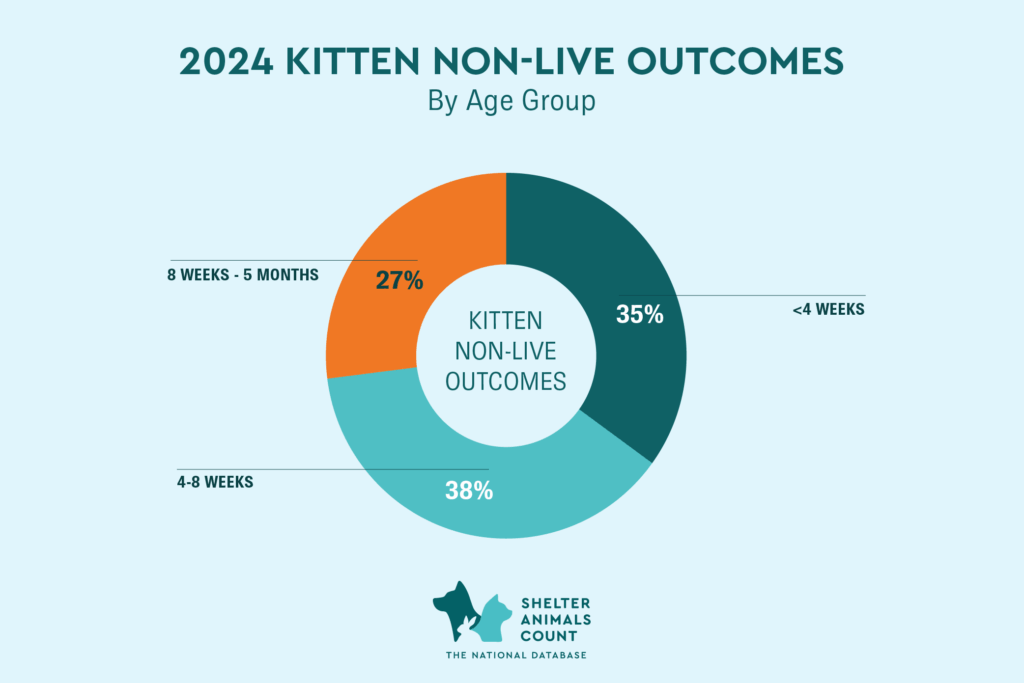
Sadly, neonatal kittens (under 4 weeks old) remain at high risk in shelters. Data shows that kittens in this age group account for 35% of non-live outcomes. Kittens aged 4-8 weeks fare slightly better but still make up 38% of non-live outcomes, emphasizing the importance of neonatal fostering programs and early medical intervention. Juvenile kittens (8 weeks to 5 months) have a significantly lower percentage (27%), reinforcing the idea that survival rates improve as kittens mature.
How This Data Can Help Shelters Prepare
Shelters and rescues can use this data to better anticipate and prepare for the rest of the year and beyond:
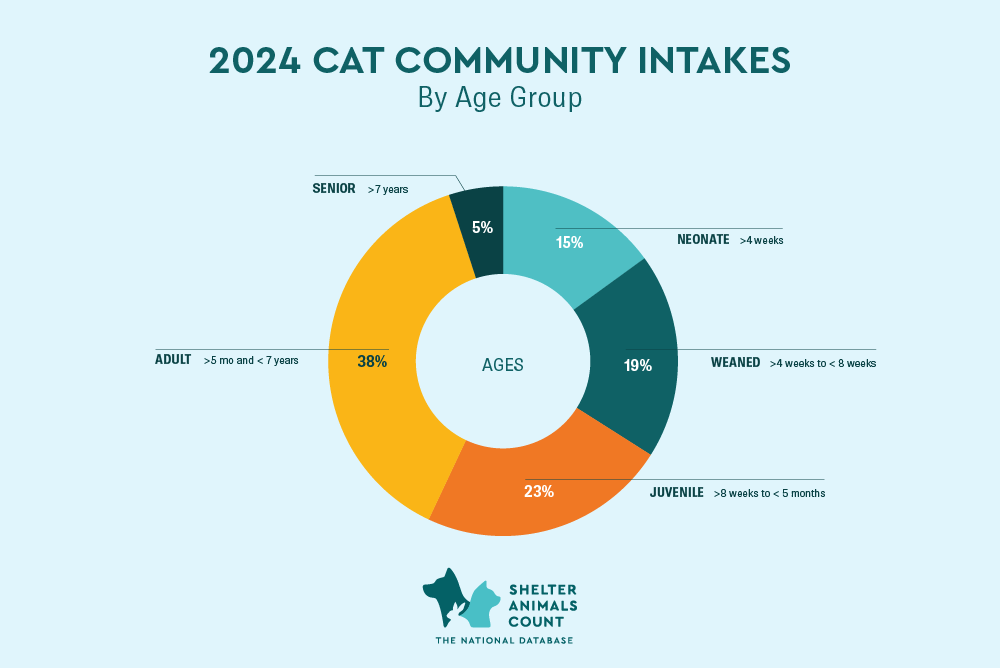
- + Strengthen Foster Programs: Since kittens under 8 weeks old face the highest risk, expanding foster networks for neonates can dramatically improve survival rates.
- + Increase Spay/Neuter Efforts: Targeted sterilization efforts, especially in regions with high kitten intake, can help reduce the seasonal surge.
- + Adjust Staffing and Resources: Planning for increased intake in spring and early summer can help shelters allocate resources more effectively.
- + Advocate for Community Support: Engaging the public in kitten fostering and adoption campaigns can alleviate the burden on shelters.
I recommend that every shelter evaluate their intake and outcome data for kittens--specifically 0-8 week olds. Because pre-adoption age kittens have such unique needs and tend to be housed with fosters, their data trends look quite different than for other age groups. When we zero in on what our data says about this specific population, that information can inform how we strategize to improve the outcomes of some of our most vulnerable animals. For example, we can look at non-live outcome types for kittens in this age group to help us understand the foster parent experience. SAC's 2024 Animal-Level Data reveals a worrying trend: that over 43% of pre-adoption age kittens who have non-live outcomes are dying unassisted (compared to about 11% for cats over 8 weeks.) This figure is incredibly variable at the shelter level, but for shelters noticing a high percentage of unassisted deaths in kittens, there are innovative strategies to give both kittens and their foster parents a better experience--and support higher foster retention, too. But it all starts with looking at our data! Data helps us identify our needs and make informed decisions that can improve our programs, support our communities, and ultimately save more lives.
Hannah Shaw, "The Kitten Lady"
A Call to Action: Submit Your Data to Shelter Animals Count
This level of analysis is only possible because of shelters and rescues submitting their data to Shelter Animals Count. The more organizations that contribute, the better we can track national trends, identify challenges, and develop solutions. If your organization isn’t yet submitting data, now is the time to start—your insights could help shape the future of animal welfare.
By understanding and acting on these trends, shelters and rescues can improve outcomes for kittens and ensure they receive the care they need during their most vulnerable stages. Let’s work together to make 2025 an even more data-driven year for animal welfare.
Don’t forget that we offer API’s for select software management systems for you to automatically transfer your data each month.
Attend our Upcoming Webinar with The Kitten Lady on May 28th
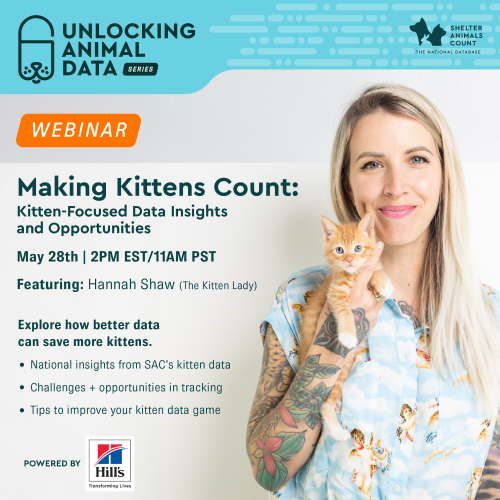
Making Kittens Count: Kitten-Focused Data Insights and Opportunities - May 28th at 2PM EST / 11AM PST
This session explores how better data-keeping for pre-adoption age kittens can drive lifesaving outcomes for the tiniest felines. Hannah will share fascinating new national insights from SAC's animal-level data, uncover the challenges and opportunities of tracking kittens, and offer practical strategies to improve how we record, understand, and act on kitten-focused data.
This webinar will be recorded and is part of our Unlocking Animal Data series, powered by Hill's Pet Nutrition.
